Substance Abuse disorders in the Aboriginal - PDF
VerifiedAdded on 2021/06/17
|16
|4757
|73
AI Summary
Contribute Materials
Your contribution can guide someone’s learning journey. Share your
documents today.
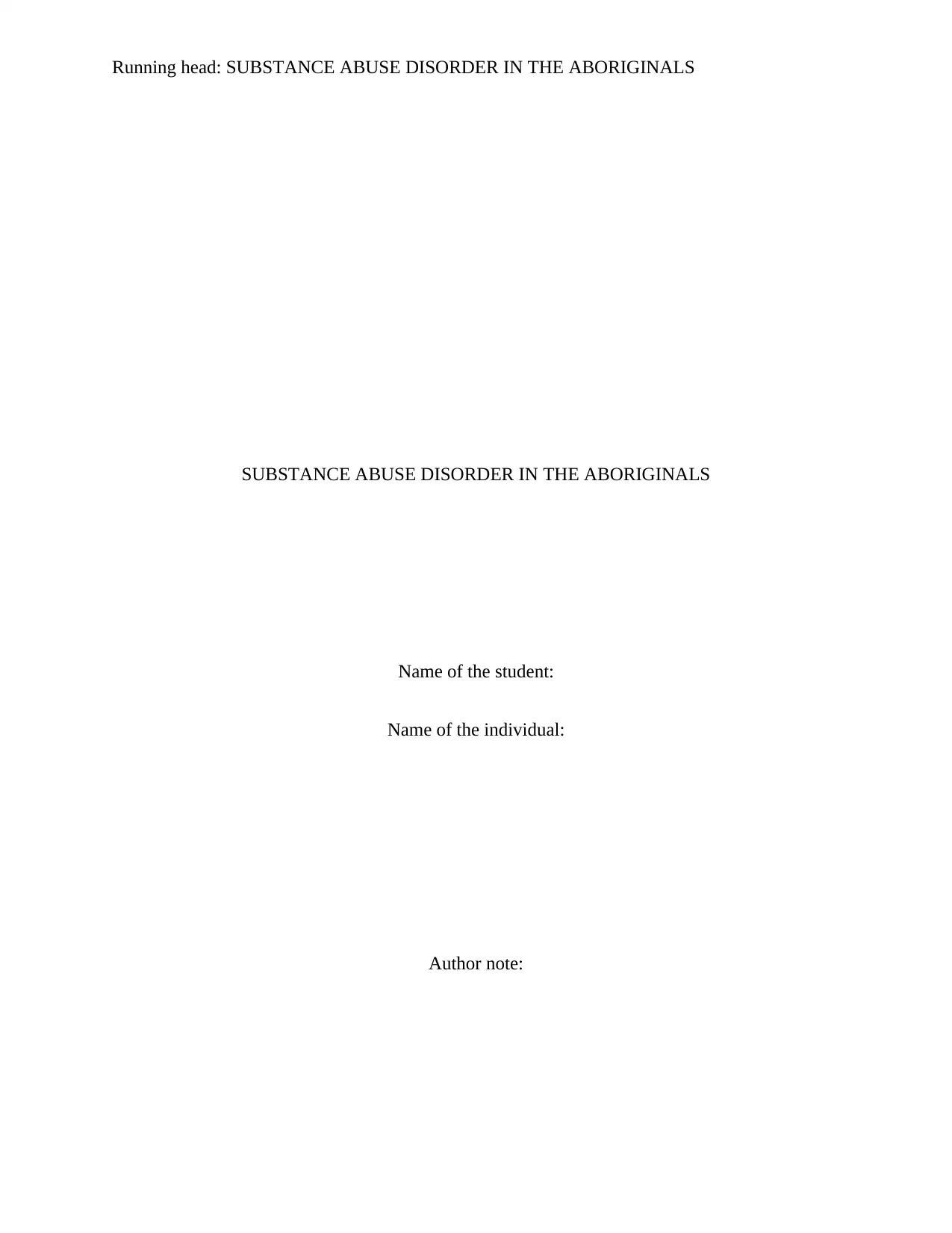
Running head: SUBSTANCE ABUSE DISORDER IN THE ABORIGINALS
SUBSTANCE ABUSE DISORDER IN THE ABORIGINALS
Name of the student:
Name of the individual:
Author note:
SUBSTANCE ABUSE DISORDER IN THE ABORIGINALS
Name of the student:
Name of the individual:
Author note:
Secure Best Marks with AI Grader
Need help grading? Try our AI Grader for instant feedback on your assignments.
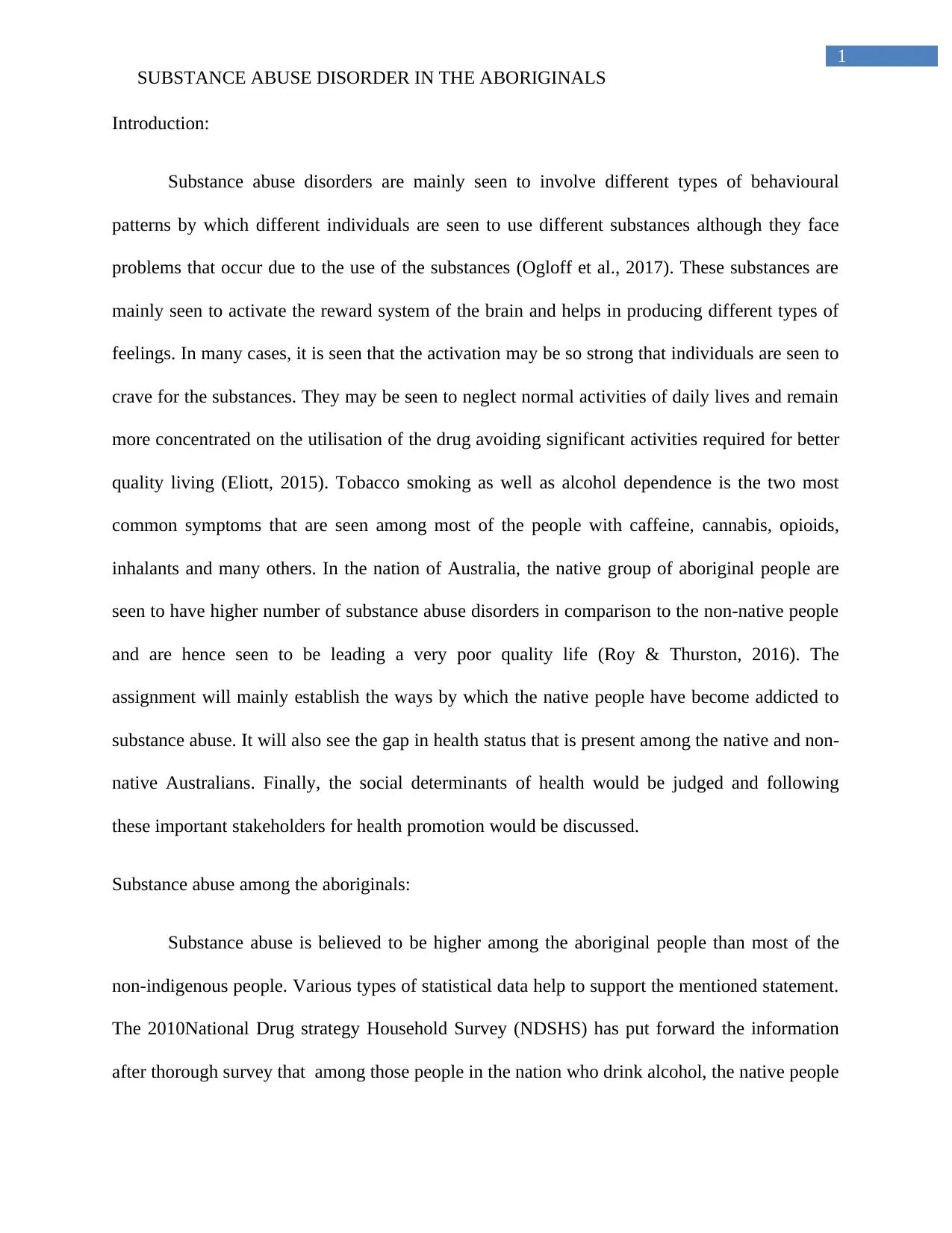
1
SUBSTANCE ABUSE DISORDER IN THE ABORIGINALS
Introduction:
Substance abuse disorders are mainly seen to involve different types of behavioural
patterns by which different individuals are seen to use different substances although they face
problems that occur due to the use of the substances (Ogloff et al., 2017). These substances are
mainly seen to activate the reward system of the brain and helps in producing different types of
feelings. In many cases, it is seen that the activation may be so strong that individuals are seen to
crave for the substances. They may be seen to neglect normal activities of daily lives and remain
more concentrated on the utilisation of the drug avoiding significant activities required for better
quality living (Eliott, 2015). Tobacco smoking as well as alcohol dependence is the two most
common symptoms that are seen among most of the people with caffeine, cannabis, opioids,
inhalants and many others. In the nation of Australia, the native group of aboriginal people are
seen to have higher number of substance abuse disorders in comparison to the non-native people
and are hence seen to be leading a very poor quality life (Roy & Thurston, 2016). The
assignment will mainly establish the ways by which the native people have become addicted to
substance abuse. It will also see the gap in health status that is present among the native and non-
native Australians. Finally, the social determinants of health would be judged and following
these important stakeholders for health promotion would be discussed.
Substance abuse among the aboriginals:
Substance abuse is believed to be higher among the aboriginal people than most of the
non-indigenous people. Various types of statistical data help to support the mentioned statement.
The 2010National Drug strategy Household Survey (NDSHS) has put forward the information
after thorough survey that among those people in the nation who drink alcohol, the native people
SUBSTANCE ABUSE DISORDER IN THE ABORIGINALS
Introduction:
Substance abuse disorders are mainly seen to involve different types of behavioural
patterns by which different individuals are seen to use different substances although they face
problems that occur due to the use of the substances (Ogloff et al., 2017). These substances are
mainly seen to activate the reward system of the brain and helps in producing different types of
feelings. In many cases, it is seen that the activation may be so strong that individuals are seen to
crave for the substances. They may be seen to neglect normal activities of daily lives and remain
more concentrated on the utilisation of the drug avoiding significant activities required for better
quality living (Eliott, 2015). Tobacco smoking as well as alcohol dependence is the two most
common symptoms that are seen among most of the people with caffeine, cannabis, opioids,
inhalants and many others. In the nation of Australia, the native group of aboriginal people are
seen to have higher number of substance abuse disorders in comparison to the non-native people
and are hence seen to be leading a very poor quality life (Roy & Thurston, 2016). The
assignment will mainly establish the ways by which the native people have become addicted to
substance abuse. It will also see the gap in health status that is present among the native and non-
native Australians. Finally, the social determinants of health would be judged and following
these important stakeholders for health promotion would be discussed.
Substance abuse among the aboriginals:
Substance abuse is believed to be higher among the aboriginal people than most of the
non-indigenous people. Various types of statistical data help to support the mentioned statement.
The 2010National Drug strategy Household Survey (NDSHS) has put forward the information
after thorough survey that among those people in the nation who drink alcohol, the native people
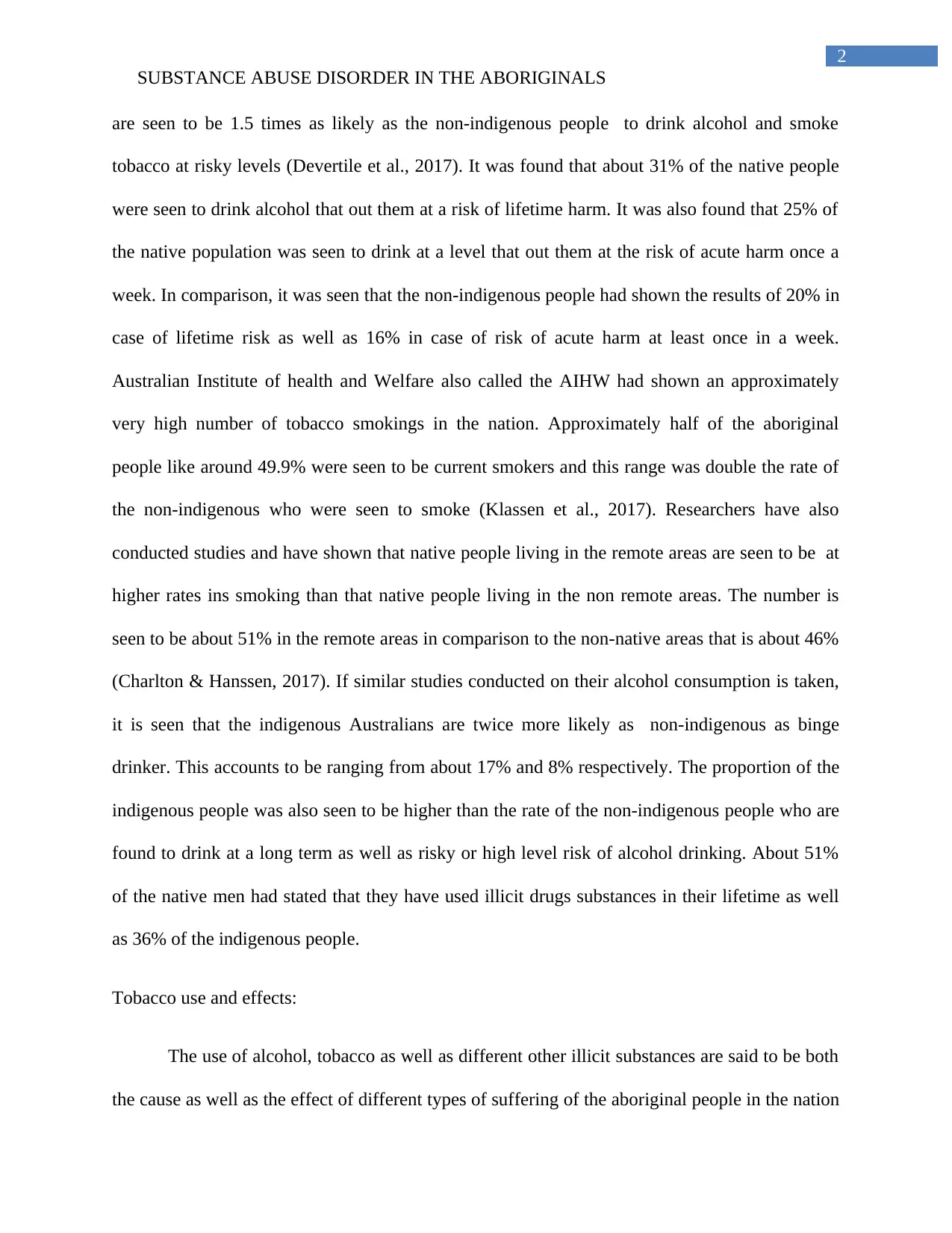
2
SUBSTANCE ABUSE DISORDER IN THE ABORIGINALS
are seen to be 1.5 times as likely as the non-indigenous people to drink alcohol and smoke
tobacco at risky levels (Devertile et al., 2017). It was found that about 31% of the native people
were seen to drink alcohol that out them at a risk of lifetime harm. It was also found that 25% of
the native population was seen to drink at a level that out them at the risk of acute harm once a
week. In comparison, it was seen that the non-indigenous people had shown the results of 20% in
case of lifetime risk as well as 16% in case of risk of acute harm at least once in a week.
Australian Institute of health and Welfare also called the AIHW had shown an approximately
very high number of tobacco smokings in the nation. Approximately half of the aboriginal
people like around 49.9% were seen to be current smokers and this range was double the rate of
the non-indigenous who were seen to smoke (Klassen et al., 2017). Researchers have also
conducted studies and have shown that native people living in the remote areas are seen to be at
higher rates ins smoking than that native people living in the non remote areas. The number is
seen to be about 51% in the remote areas in comparison to the non-native areas that is about 46%
(Charlton & Hanssen, 2017). If similar studies conducted on their alcohol consumption is taken,
it is seen that the indigenous Australians are twice more likely as non-indigenous as binge
drinker. This accounts to be ranging from about 17% and 8% respectively. The proportion of the
indigenous people was also seen to be higher than the rate of the non-indigenous people who are
found to drink at a long term as well as risky or high level risk of alcohol drinking. About 51%
of the native men had stated that they have used illicit drugs substances in their lifetime as well
as 36% of the indigenous people.
Tobacco use and effects:
The use of alcohol, tobacco as well as different other illicit substances are said to be both
the cause as well as the effect of different types of suffering of the aboriginal people in the nation
SUBSTANCE ABUSE DISORDER IN THE ABORIGINALS
are seen to be 1.5 times as likely as the non-indigenous people to drink alcohol and smoke
tobacco at risky levels (Devertile et al., 2017). It was found that about 31% of the native people
were seen to drink alcohol that out them at a risk of lifetime harm. It was also found that 25% of
the native population was seen to drink at a level that out them at the risk of acute harm once a
week. In comparison, it was seen that the non-indigenous people had shown the results of 20% in
case of lifetime risk as well as 16% in case of risk of acute harm at least once in a week.
Australian Institute of health and Welfare also called the AIHW had shown an approximately
very high number of tobacco smokings in the nation. Approximately half of the aboriginal
people like around 49.9% were seen to be current smokers and this range was double the rate of
the non-indigenous who were seen to smoke (Klassen et al., 2017). Researchers have also
conducted studies and have shown that native people living in the remote areas are seen to be at
higher rates ins smoking than that native people living in the non remote areas. The number is
seen to be about 51% in the remote areas in comparison to the non-native areas that is about 46%
(Charlton & Hanssen, 2017). If similar studies conducted on their alcohol consumption is taken,
it is seen that the indigenous Australians are twice more likely as non-indigenous as binge
drinker. This accounts to be ranging from about 17% and 8% respectively. The proportion of the
indigenous people was also seen to be higher than the rate of the non-indigenous people who are
found to drink at a long term as well as risky or high level risk of alcohol drinking. About 51%
of the native men had stated that they have used illicit drugs substances in their lifetime as well
as 36% of the indigenous people.
Tobacco use and effects:
The use of alcohol, tobacco as well as different other illicit substances are said to be both
the cause as well as the effect of different types of suffering of the aboriginal people in the nation
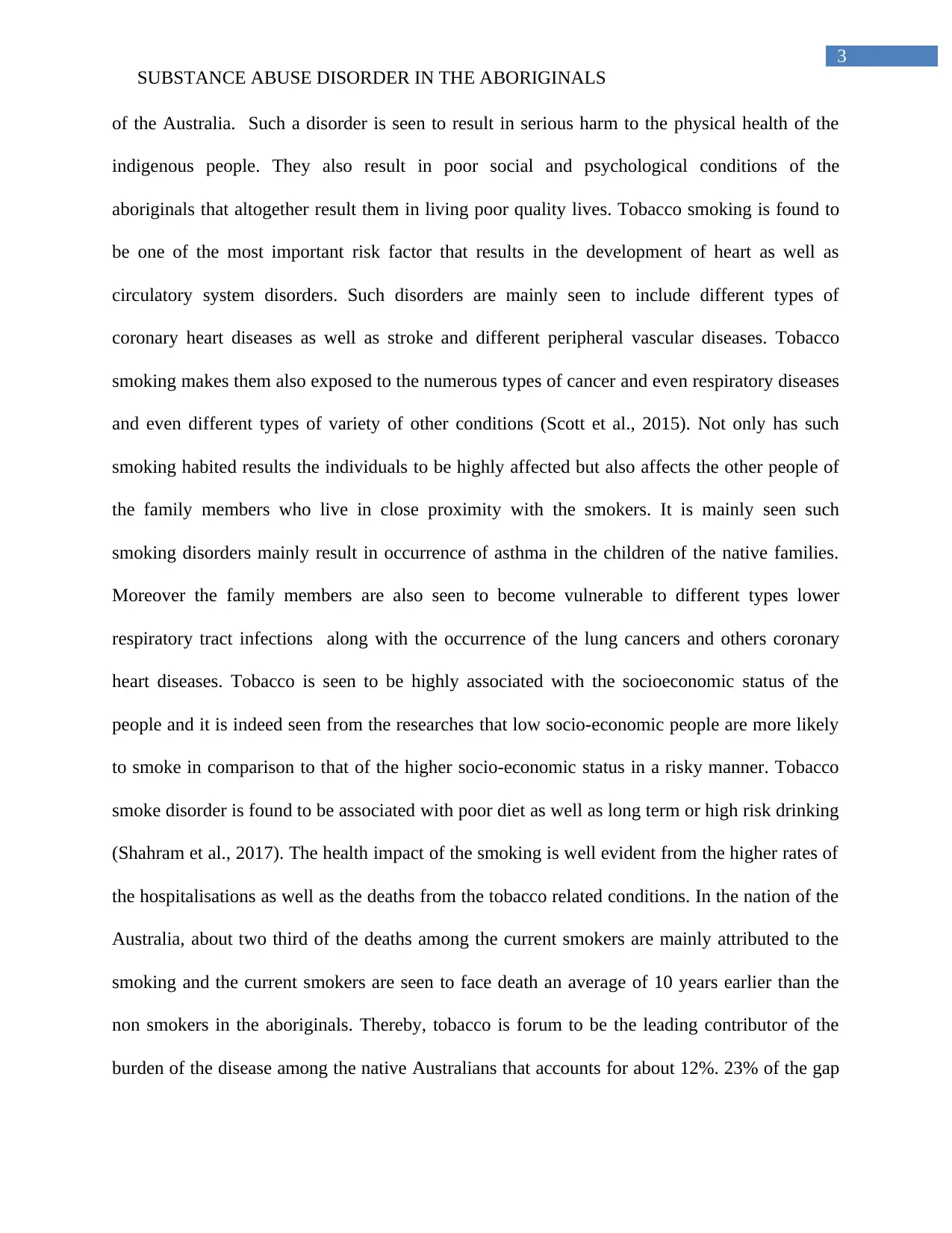
3
SUBSTANCE ABUSE DISORDER IN THE ABORIGINALS
of the Australia. Such a disorder is seen to result in serious harm to the physical health of the
indigenous people. They also result in poor social and psychological conditions of the
aboriginals that altogether result them in living poor quality lives. Tobacco smoking is found to
be one of the most important risk factor that results in the development of heart as well as
circulatory system disorders. Such disorders are mainly seen to include different types of
coronary heart diseases as well as stroke and different peripheral vascular diseases. Tobacco
smoking makes them also exposed to the numerous types of cancer and even respiratory diseases
and even different types of variety of other conditions (Scott et al., 2015). Not only has such
smoking habited results the individuals to be highly affected but also affects the other people of
the family members who live in close proximity with the smokers. It is mainly seen such
smoking disorders mainly result in occurrence of asthma in the children of the native families.
Moreover the family members are also seen to become vulnerable to different types lower
respiratory tract infections along with the occurrence of the lung cancers and others coronary
heart diseases. Tobacco is seen to be highly associated with the socioeconomic status of the
people and it is indeed seen from the researches that low socio-economic people are more likely
to smoke in comparison to that of the higher socio-economic status in a risky manner. Tobacco
smoke disorder is found to be associated with poor diet as well as long term or high risk drinking
(Shahram et al., 2017). The health impact of the smoking is well evident from the higher rates of
the hospitalisations as well as the deaths from the tobacco related conditions. In the nation of the
Australia, about two third of the deaths among the current smokers are mainly attributed to the
smoking and the current smokers are seen to face death an average of 10 years earlier than the
non smokers in the aboriginals. Thereby, tobacco is forum to be the leading contributor of the
burden of the disease among the native Australians that accounts for about 12%. 23% of the gap
SUBSTANCE ABUSE DISORDER IN THE ABORIGINALS
of the Australia. Such a disorder is seen to result in serious harm to the physical health of the
indigenous people. They also result in poor social and psychological conditions of the
aboriginals that altogether result them in living poor quality lives. Tobacco smoking is found to
be one of the most important risk factor that results in the development of heart as well as
circulatory system disorders. Such disorders are mainly seen to include different types of
coronary heart diseases as well as stroke and different peripheral vascular diseases. Tobacco
smoking makes them also exposed to the numerous types of cancer and even respiratory diseases
and even different types of variety of other conditions (Scott et al., 2015). Not only has such
smoking habited results the individuals to be highly affected but also affects the other people of
the family members who live in close proximity with the smokers. It is mainly seen such
smoking disorders mainly result in occurrence of asthma in the children of the native families.
Moreover the family members are also seen to become vulnerable to different types lower
respiratory tract infections along with the occurrence of the lung cancers and others coronary
heart diseases. Tobacco is seen to be highly associated with the socioeconomic status of the
people and it is indeed seen from the researches that low socio-economic people are more likely
to smoke in comparison to that of the higher socio-economic status in a risky manner. Tobacco
smoke disorder is found to be associated with poor diet as well as long term or high risk drinking
(Shahram et al., 2017). The health impact of the smoking is well evident from the higher rates of
the hospitalisations as well as the deaths from the tobacco related conditions. In the nation of the
Australia, about two third of the deaths among the current smokers are mainly attributed to the
smoking and the current smokers are seen to face death an average of 10 years earlier than the
non smokers in the aboriginals. Thereby, tobacco is forum to be the leading contributor of the
burden of the disease among the native Australians that accounts for about 12%. 23% of the gap
Secure Best Marks with AI Grader
Need help grading? Try our AI Grader for instant feedback on your assignments.
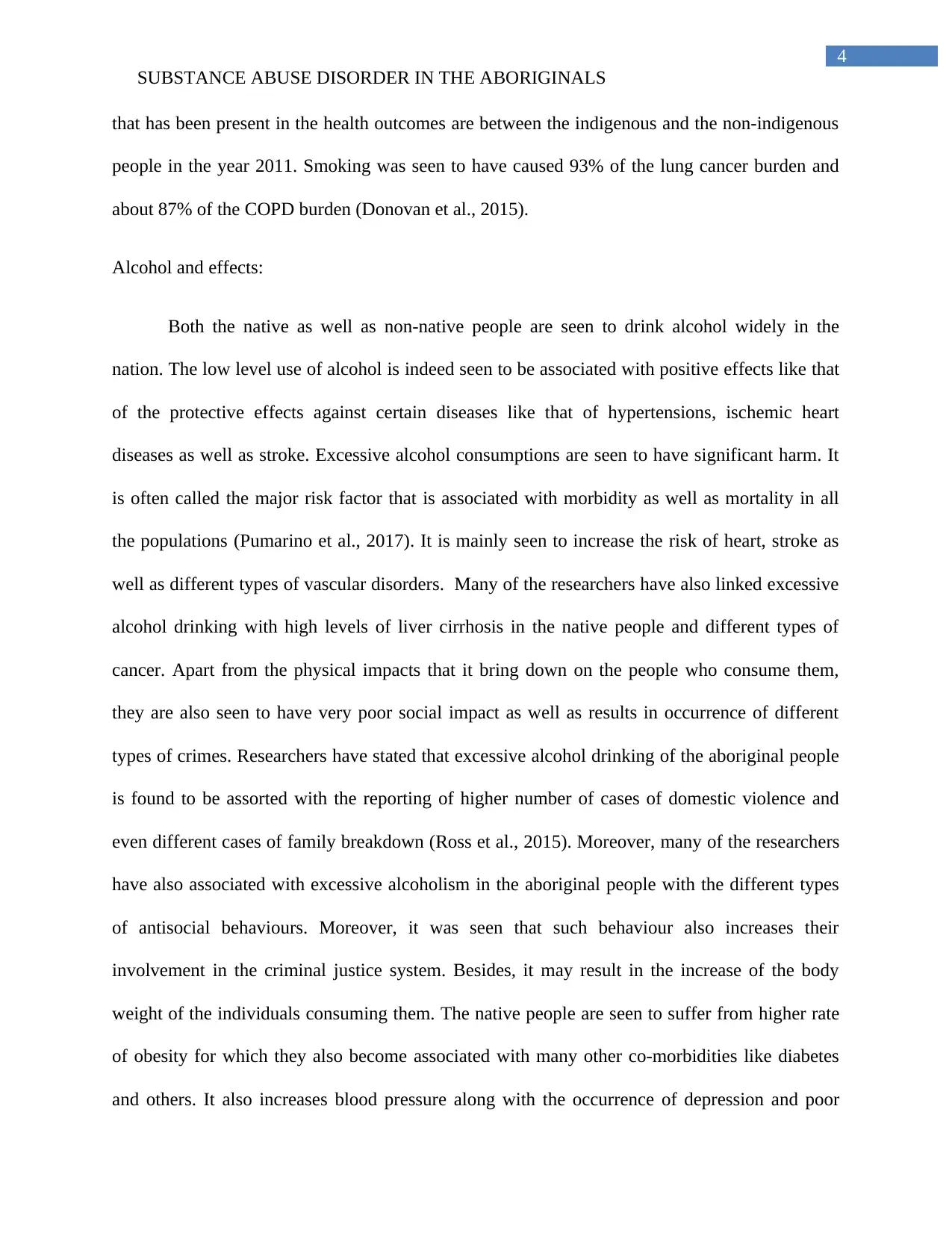
4
SUBSTANCE ABUSE DISORDER IN THE ABORIGINALS
that has been present in the health outcomes are between the indigenous and the non-indigenous
people in the year 2011. Smoking was seen to have caused 93% of the lung cancer burden and
about 87% of the COPD burden (Donovan et al., 2015).
Alcohol and effects:
Both the native as well as non-native people are seen to drink alcohol widely in the
nation. The low level use of alcohol is indeed seen to be associated with positive effects like that
of the protective effects against certain diseases like that of hypertensions, ischemic heart
diseases as well as stroke. Excessive alcohol consumptions are seen to have significant harm. It
is often called the major risk factor that is associated with morbidity as well as mortality in all
the populations (Pumarino et al., 2017). It is mainly seen to increase the risk of heart, stroke as
well as different types of vascular disorders. Many of the researchers have also linked excessive
alcohol drinking with high levels of liver cirrhosis in the native people and different types of
cancer. Apart from the physical impacts that it bring down on the people who consume them,
they are also seen to have very poor social impact as well as results in occurrence of different
types of crimes. Researchers have stated that excessive alcohol drinking of the aboriginal people
is found to be assorted with the reporting of higher number of cases of domestic violence and
even different cases of family breakdown (Ross et al., 2015). Moreover, many of the researchers
have also associated with excessive alcoholism in the aboriginal people with the different types
of antisocial behaviours. Moreover, it was seen that such behaviour also increases their
involvement in the criminal justice system. Besides, it may result in the increase of the body
weight of the individuals consuming them. The native people are seen to suffer from higher rate
of obesity for which they also become associated with many other co-morbidities like diabetes
and others. It also increases blood pressure along with the occurrence of depression and poor
SUBSTANCE ABUSE DISORDER IN THE ABORIGINALS
that has been present in the health outcomes are between the indigenous and the non-indigenous
people in the year 2011. Smoking was seen to have caused 93% of the lung cancer burden and
about 87% of the COPD burden (Donovan et al., 2015).
Alcohol and effects:
Both the native as well as non-native people are seen to drink alcohol widely in the
nation. The low level use of alcohol is indeed seen to be associated with positive effects like that
of the protective effects against certain diseases like that of hypertensions, ischemic heart
diseases as well as stroke. Excessive alcohol consumptions are seen to have significant harm. It
is often called the major risk factor that is associated with morbidity as well as mortality in all
the populations (Pumarino et al., 2017). It is mainly seen to increase the risk of heart, stroke as
well as different types of vascular disorders. Many of the researchers have also linked excessive
alcohol drinking with high levels of liver cirrhosis in the native people and different types of
cancer. Apart from the physical impacts that it bring down on the people who consume them,
they are also seen to have very poor social impact as well as results in occurrence of different
types of crimes. Researchers have stated that excessive alcohol drinking of the aboriginal people
is found to be assorted with the reporting of higher number of cases of domestic violence and
even different cases of family breakdown (Ross et al., 2015). Moreover, many of the researchers
have also associated with excessive alcoholism in the aboriginal people with the different types
of antisocial behaviours. Moreover, it was seen that such behaviour also increases their
involvement in the criminal justice system. Besides, it may result in the increase of the body
weight of the individuals consuming them. The native people are seen to suffer from higher rate
of obesity for which they also become associated with many other co-morbidities like diabetes
and others. It also increases blood pressure along with the occurrence of depression and poor
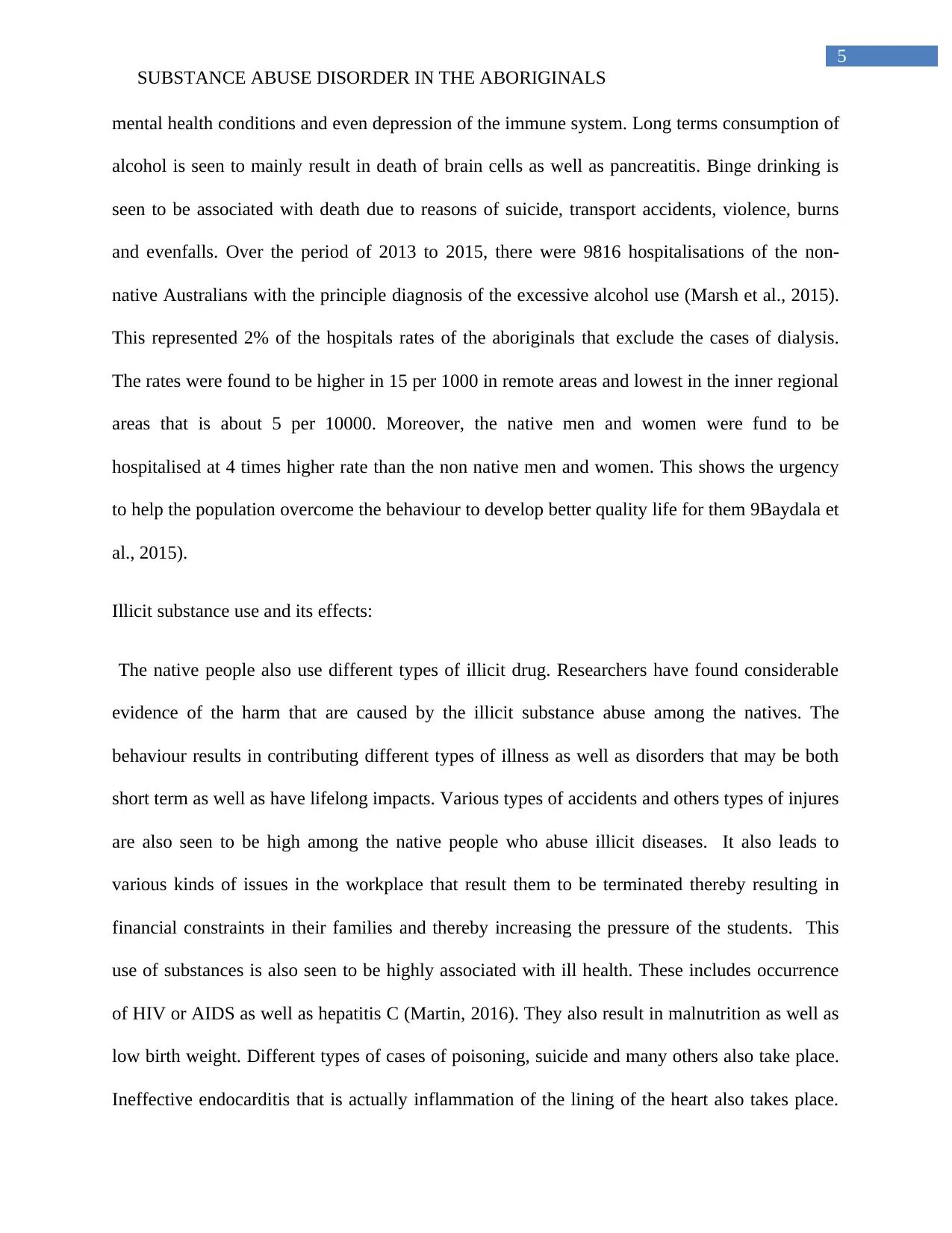
5
SUBSTANCE ABUSE DISORDER IN THE ABORIGINALS
mental health conditions and even depression of the immune system. Long terms consumption of
alcohol is seen to mainly result in death of brain cells as well as pancreatitis. Binge drinking is
seen to be associated with death due to reasons of suicide, transport accidents, violence, burns
and evenfalls. Over the period of 2013 to 2015, there were 9816 hospitalisations of the non-
native Australians with the principle diagnosis of the excessive alcohol use (Marsh et al., 2015).
This represented 2% of the hospitals rates of the aboriginals that exclude the cases of dialysis.
The rates were found to be higher in 15 per 1000 in remote areas and lowest in the inner regional
areas that is about 5 per 10000. Moreover, the native men and women were fund to be
hospitalised at 4 times higher rate than the non native men and women. This shows the urgency
to help the population overcome the behaviour to develop better quality life for them 9Baydala et
al., 2015).
Illicit substance use and its effects:
The native people also use different types of illicit drug. Researchers have found considerable
evidence of the harm that are caused by the illicit substance abuse among the natives. The
behaviour results in contributing different types of illness as well as disorders that may be both
short term as well as have lifelong impacts. Various types of accidents and others types of injures
are also seen to be high among the native people who abuse illicit diseases. It also leads to
various kinds of issues in the workplace that result them to be terminated thereby resulting in
financial constraints in their families and thereby increasing the pressure of the students. This
use of substances is also seen to be highly associated with ill health. These includes occurrence
of HIV or AIDS as well as hepatitis C (Martin, 2016). They also result in malnutrition as well as
low birth weight. Different types of cases of poisoning, suicide and many others also take place.
Ineffective endocarditis that is actually inflammation of the lining of the heart also takes place.
SUBSTANCE ABUSE DISORDER IN THE ABORIGINALS
mental health conditions and even depression of the immune system. Long terms consumption of
alcohol is seen to mainly result in death of brain cells as well as pancreatitis. Binge drinking is
seen to be associated with death due to reasons of suicide, transport accidents, violence, burns
and evenfalls. Over the period of 2013 to 2015, there were 9816 hospitalisations of the non-
native Australians with the principle diagnosis of the excessive alcohol use (Marsh et al., 2015).
This represented 2% of the hospitals rates of the aboriginals that exclude the cases of dialysis.
The rates were found to be higher in 15 per 1000 in remote areas and lowest in the inner regional
areas that is about 5 per 10000. Moreover, the native men and women were fund to be
hospitalised at 4 times higher rate than the non native men and women. This shows the urgency
to help the population overcome the behaviour to develop better quality life for them 9Baydala et
al., 2015).
Illicit substance use and its effects:
The native people also use different types of illicit drug. Researchers have found considerable
evidence of the harm that are caused by the illicit substance abuse among the natives. The
behaviour results in contributing different types of illness as well as disorders that may be both
short term as well as have lifelong impacts. Various types of accidents and others types of injures
are also seen to be high among the native people who abuse illicit diseases. It also leads to
various kinds of issues in the workplace that result them to be terminated thereby resulting in
financial constraints in their families and thereby increasing the pressure of the students. This
use of substances is also seen to be highly associated with ill health. These includes occurrence
of HIV or AIDS as well as hepatitis C (Martin, 2016). They also result in malnutrition as well as
low birth weight. Different types of cases of poisoning, suicide and many others also take place.
Ineffective endocarditis that is actually inflammation of the lining of the heart also takes place.
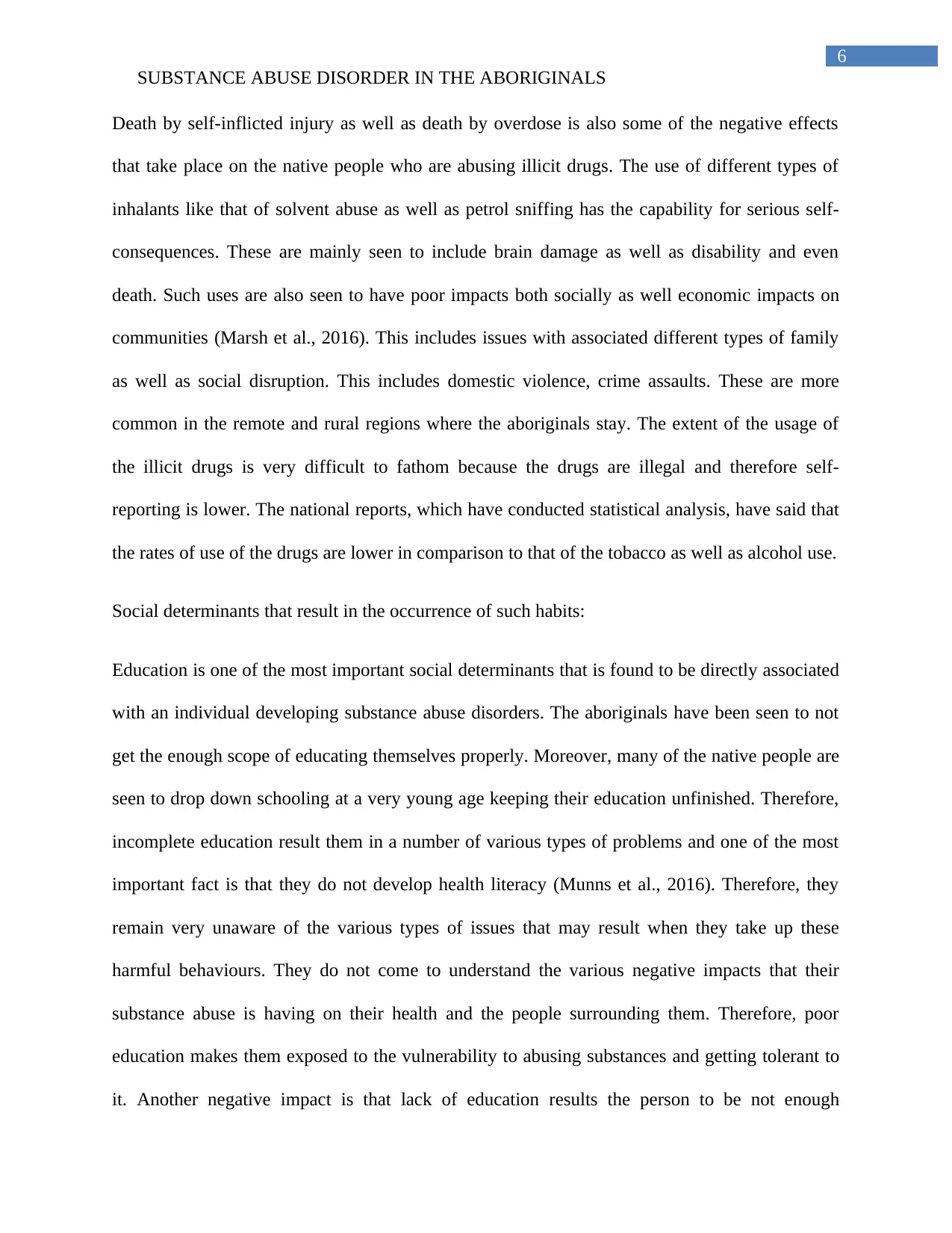
6
SUBSTANCE ABUSE DISORDER IN THE ABORIGINALS
Death by self-inflicted injury as well as death by overdose is also some of the negative effects
that take place on the native people who are abusing illicit drugs. The use of different types of
inhalants like that of solvent abuse as well as petrol sniffing has the capability for serious self-
consequences. These are mainly seen to include brain damage as well as disability and even
death. Such uses are also seen to have poor impacts both socially as well economic impacts on
communities (Marsh et al., 2016). This includes issues with associated different types of family
as well as social disruption. This includes domestic violence, crime assaults. These are more
common in the remote and rural regions where the aboriginals stay. The extent of the usage of
the illicit drugs is very difficult to fathom because the drugs are illegal and therefore self-
reporting is lower. The national reports, which have conducted statistical analysis, have said that
the rates of use of the drugs are lower in comparison to that of the tobacco as well as alcohol use.
Social determinants that result in the occurrence of such habits:
Education is one of the most important social determinants that is found to be directly associated
with an individual developing substance abuse disorders. The aboriginals have been seen to not
get the enough scope of educating themselves properly. Moreover, many of the native people are
seen to drop down schooling at a very young age keeping their education unfinished. Therefore,
incomplete education result them in a number of various types of problems and one of the most
important fact is that they do not develop health literacy (Munns et al., 2016). Therefore, they
remain very unaware of the various types of issues that may result when they take up these
harmful behaviours. They do not come to understand the various negative impacts that their
substance abuse is having on their health and the people surrounding them. Therefore, poor
education makes them exposed to the vulnerability to abusing substances and getting tolerant to
it. Another negative impact is that lack of education results the person to be not enough
SUBSTANCE ABUSE DISORDER IN THE ABORIGINALS
Death by self-inflicted injury as well as death by overdose is also some of the negative effects
that take place on the native people who are abusing illicit drugs. The use of different types of
inhalants like that of solvent abuse as well as petrol sniffing has the capability for serious self-
consequences. These are mainly seen to include brain damage as well as disability and even
death. Such uses are also seen to have poor impacts both socially as well economic impacts on
communities (Marsh et al., 2016). This includes issues with associated different types of family
as well as social disruption. This includes domestic violence, crime assaults. These are more
common in the remote and rural regions where the aboriginals stay. The extent of the usage of
the illicit drugs is very difficult to fathom because the drugs are illegal and therefore self-
reporting is lower. The national reports, which have conducted statistical analysis, have said that
the rates of use of the drugs are lower in comparison to that of the tobacco as well as alcohol use.
Social determinants that result in the occurrence of such habits:
Education is one of the most important social determinants that is found to be directly associated
with an individual developing substance abuse disorders. The aboriginals have been seen to not
get the enough scope of educating themselves properly. Moreover, many of the native people are
seen to drop down schooling at a very young age keeping their education unfinished. Therefore,
incomplete education result them in a number of various types of problems and one of the most
important fact is that they do not develop health literacy (Munns et al., 2016). Therefore, they
remain very unaware of the various types of issues that may result when they take up these
harmful behaviours. They do not come to understand the various negative impacts that their
substance abuse is having on their health and the people surrounding them. Therefore, poor
education makes them exposed to the vulnerability to abusing substances and getting tolerant to
it. Another negative impact is that lack of education results the person to be not enough
Paraphrase This Document
Need a fresh take? Get an instant paraphrase of this document with our AI Paraphraser
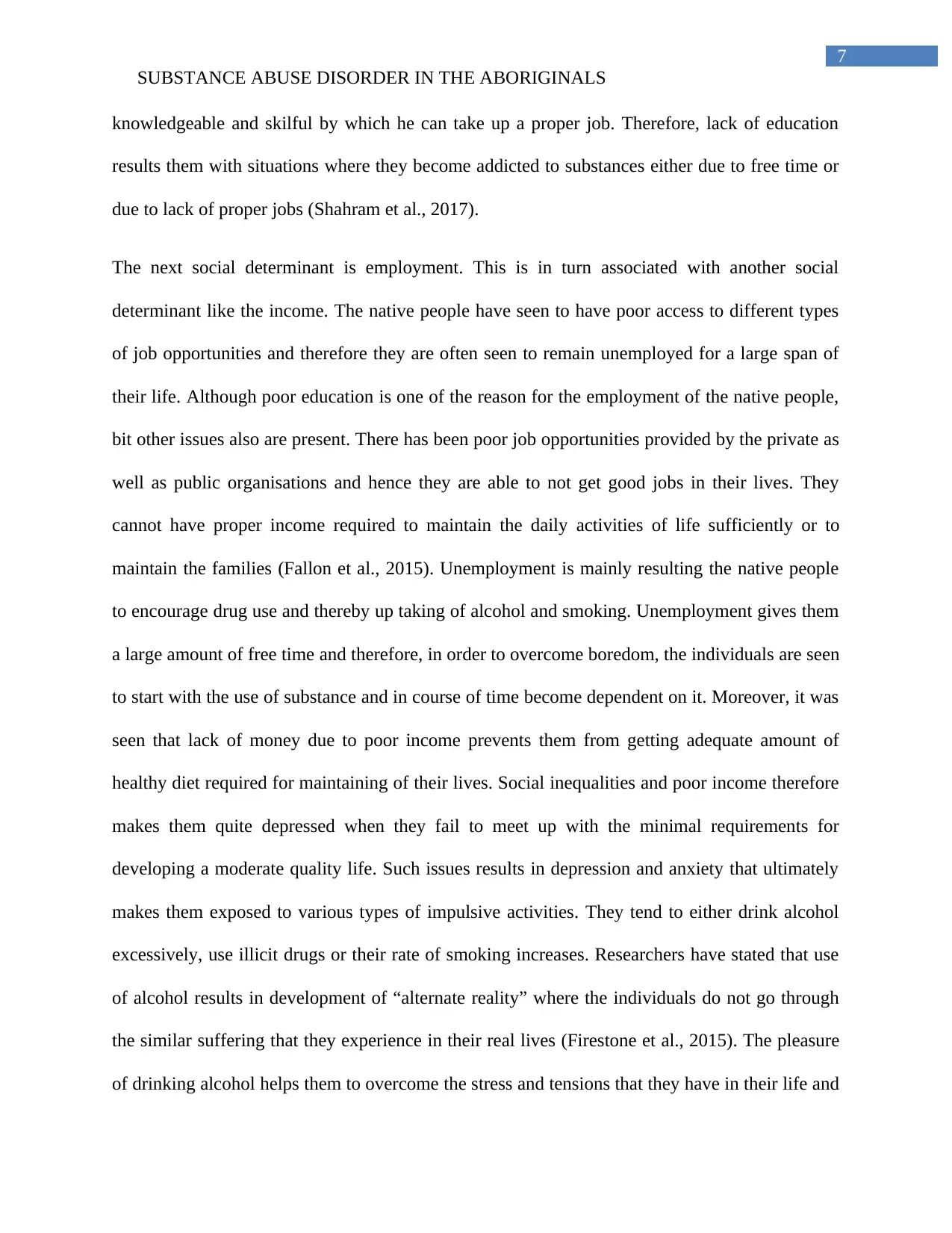
7
SUBSTANCE ABUSE DISORDER IN THE ABORIGINALS
knowledgeable and skilful by which he can take up a proper job. Therefore, lack of education
results them with situations where they become addicted to substances either due to free time or
due to lack of proper jobs (Shahram et al., 2017).
The next social determinant is employment. This is in turn associated with another social
determinant like the income. The native people have seen to have poor access to different types
of job opportunities and therefore they are often seen to remain unemployed for a large span of
their life. Although poor education is one of the reason for the employment of the native people,
bit other issues also are present. There has been poor job opportunities provided by the private as
well as public organisations and hence they are able to not get good jobs in their lives. They
cannot have proper income required to maintain the daily activities of life sufficiently or to
maintain the families (Fallon et al., 2015). Unemployment is mainly resulting the native people
to encourage drug use and thereby up taking of alcohol and smoking. Unemployment gives them
a large amount of free time and therefore, in order to overcome boredom, the individuals are seen
to start with the use of substance and in course of time become dependent on it. Moreover, it was
seen that lack of money due to poor income prevents them from getting adequate amount of
healthy diet required for maintaining of their lives. Social inequalities and poor income therefore
makes them quite depressed when they fail to meet up with the minimal requirements for
developing a moderate quality life. Such issues results in depression and anxiety that ultimately
makes them exposed to various types of impulsive activities. They tend to either drink alcohol
excessively, use illicit drugs or their rate of smoking increases. Researchers have stated that use
of alcohol results in development of “alternate reality” where the individuals do not go through
the similar suffering that they experience in their real lives (Firestone et al., 2015). The pleasure
of drinking alcohol helps them to overcome the stress and tensions that they have in their life and
SUBSTANCE ABUSE DISORDER IN THE ABORIGINALS
knowledgeable and skilful by which he can take up a proper job. Therefore, lack of education
results them with situations where they become addicted to substances either due to free time or
due to lack of proper jobs (Shahram et al., 2017).
The next social determinant is employment. This is in turn associated with another social
determinant like the income. The native people have seen to have poor access to different types
of job opportunities and therefore they are often seen to remain unemployed for a large span of
their life. Although poor education is one of the reason for the employment of the native people,
bit other issues also are present. There has been poor job opportunities provided by the private as
well as public organisations and hence they are able to not get good jobs in their lives. They
cannot have proper income required to maintain the daily activities of life sufficiently or to
maintain the families (Fallon et al., 2015). Unemployment is mainly resulting the native people
to encourage drug use and thereby up taking of alcohol and smoking. Unemployment gives them
a large amount of free time and therefore, in order to overcome boredom, the individuals are seen
to start with the use of substance and in course of time become dependent on it. Moreover, it was
seen that lack of money due to poor income prevents them from getting adequate amount of
healthy diet required for maintaining of their lives. Social inequalities and poor income therefore
makes them quite depressed when they fail to meet up with the minimal requirements for
developing a moderate quality life. Such issues results in depression and anxiety that ultimately
makes them exposed to various types of impulsive activities. They tend to either drink alcohol
excessively, use illicit drugs or their rate of smoking increases. Researchers have stated that use
of alcohol results in development of “alternate reality” where the individuals do not go through
the similar suffering that they experience in their real lives (Firestone et al., 2015). The pleasure
of drinking alcohol helps them to overcome the stress and tensions that they have in their life and
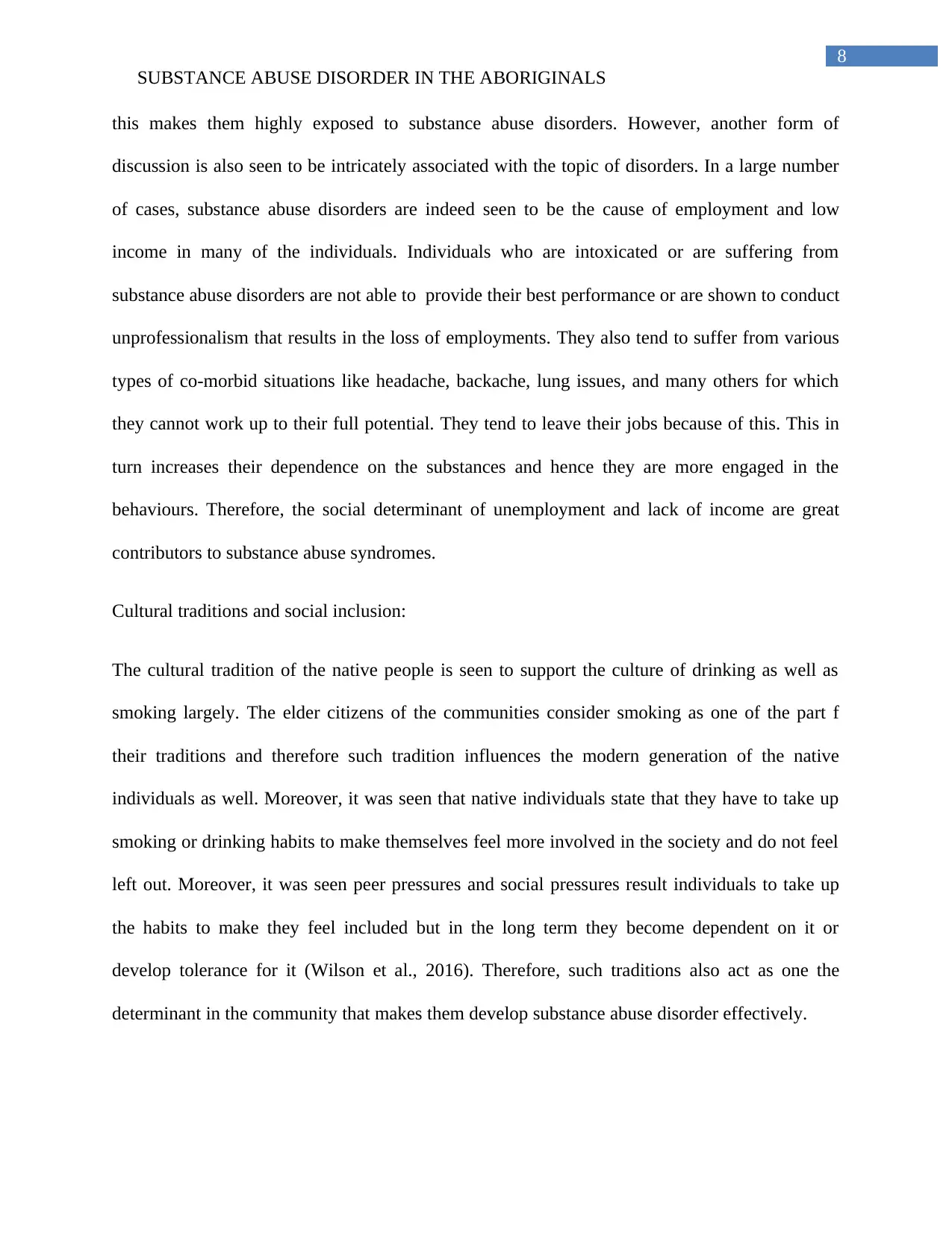
8
SUBSTANCE ABUSE DISORDER IN THE ABORIGINALS
this makes them highly exposed to substance abuse disorders. However, another form of
discussion is also seen to be intricately associated with the topic of disorders. In a large number
of cases, substance abuse disorders are indeed seen to be the cause of employment and low
income in many of the individuals. Individuals who are intoxicated or are suffering from
substance abuse disorders are not able to provide their best performance or are shown to conduct
unprofessionalism that results in the loss of employments. They also tend to suffer from various
types of co-morbid situations like headache, backache, lung issues, and many others for which
they cannot work up to their full potential. They tend to leave their jobs because of this. This in
turn increases their dependence on the substances and hence they are more engaged in the
behaviours. Therefore, the social determinant of unemployment and lack of income are great
contributors to substance abuse syndromes.
Cultural traditions and social inclusion:
The cultural tradition of the native people is seen to support the culture of drinking as well as
smoking largely. The elder citizens of the communities consider smoking as one of the part f
their traditions and therefore such tradition influences the modern generation of the native
individuals as well. Moreover, it was seen that native individuals state that they have to take up
smoking or drinking habits to make themselves feel more involved in the society and do not feel
left out. Moreover, it was seen peer pressures and social pressures result individuals to take up
the habits to make they feel included but in the long term they become dependent on it or
develop tolerance for it (Wilson et al., 2016). Therefore, such traditions also act as one the
determinant in the community that makes them develop substance abuse disorder effectively.
SUBSTANCE ABUSE DISORDER IN THE ABORIGINALS
this makes them highly exposed to substance abuse disorders. However, another form of
discussion is also seen to be intricately associated with the topic of disorders. In a large number
of cases, substance abuse disorders are indeed seen to be the cause of employment and low
income in many of the individuals. Individuals who are intoxicated or are suffering from
substance abuse disorders are not able to provide their best performance or are shown to conduct
unprofessionalism that results in the loss of employments. They also tend to suffer from various
types of co-morbid situations like headache, backache, lung issues, and many others for which
they cannot work up to their full potential. They tend to leave their jobs because of this. This in
turn increases their dependence on the substances and hence they are more engaged in the
behaviours. Therefore, the social determinant of unemployment and lack of income are great
contributors to substance abuse syndromes.
Cultural traditions and social inclusion:
The cultural tradition of the native people is seen to support the culture of drinking as well as
smoking largely. The elder citizens of the communities consider smoking as one of the part f
their traditions and therefore such tradition influences the modern generation of the native
individuals as well. Moreover, it was seen that native individuals state that they have to take up
smoking or drinking habits to make themselves feel more involved in the society and do not feel
left out. Moreover, it was seen peer pressures and social pressures result individuals to take up
the habits to make they feel included but in the long term they become dependent on it or
develop tolerance for it (Wilson et al., 2016). Therefore, such traditions also act as one the
determinant in the community that makes them develop substance abuse disorder effectively.
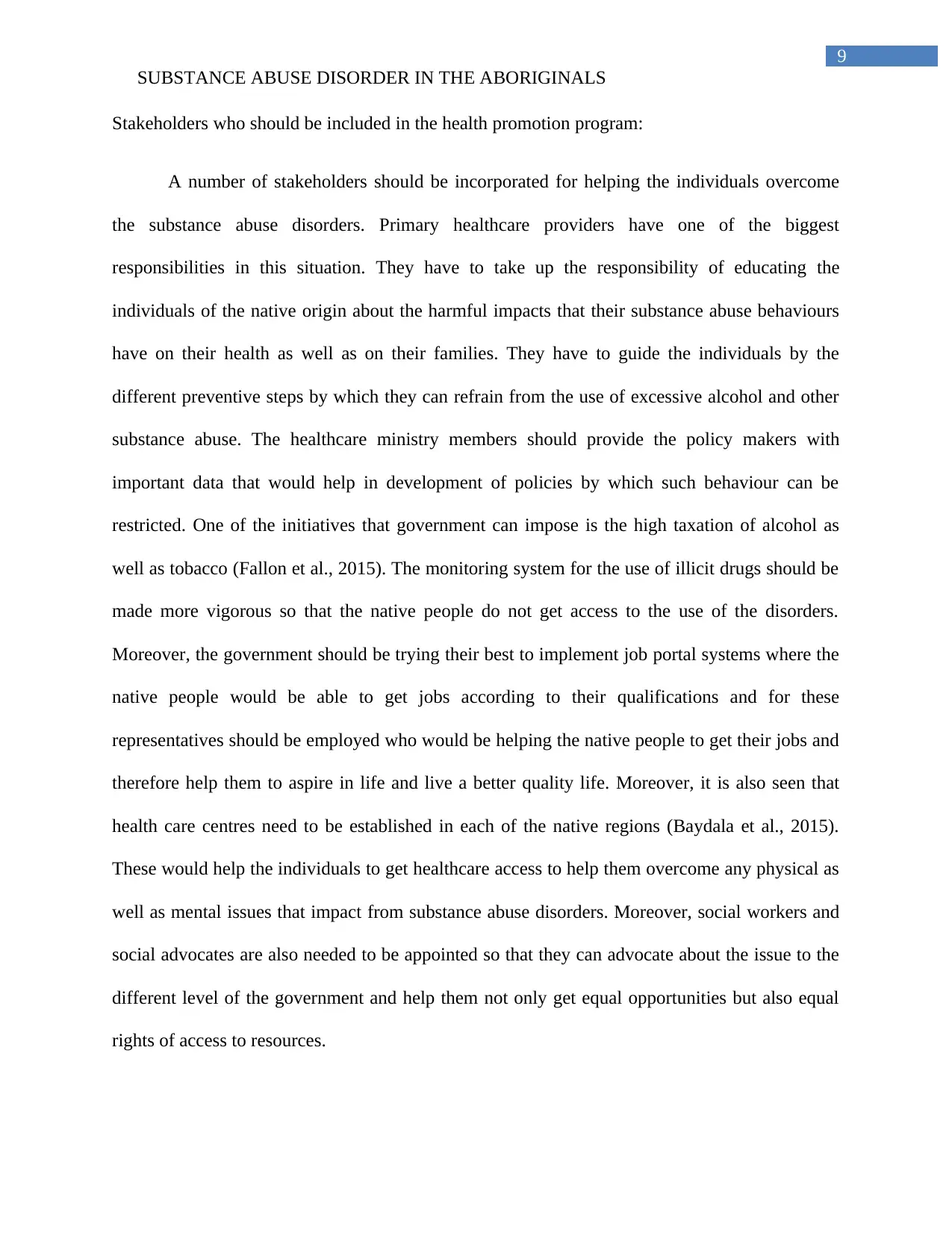
9
SUBSTANCE ABUSE DISORDER IN THE ABORIGINALS
Stakeholders who should be included in the health promotion program:
A number of stakeholders should be incorporated for helping the individuals overcome
the substance abuse disorders. Primary healthcare providers have one of the biggest
responsibilities in this situation. They have to take up the responsibility of educating the
individuals of the native origin about the harmful impacts that their substance abuse behaviours
have on their health as well as on their families. They have to guide the individuals by the
different preventive steps by which they can refrain from the use of excessive alcohol and other
substance abuse. The healthcare ministry members should provide the policy makers with
important data that would help in development of policies by which such behaviour can be
restricted. One of the initiatives that government can impose is the high taxation of alcohol as
well as tobacco (Fallon et al., 2015). The monitoring system for the use of illicit drugs should be
made more vigorous so that the native people do not get access to the use of the disorders.
Moreover, the government should be trying their best to implement job portal systems where the
native people would be able to get jobs according to their qualifications and for these
representatives should be employed who would be helping the native people to get their jobs and
therefore help them to aspire in life and live a better quality life. Moreover, it is also seen that
health care centres need to be established in each of the native regions (Baydala et al., 2015).
These would help the individuals to get healthcare access to help them overcome any physical as
well as mental issues that impact from substance abuse disorders. Moreover, social workers and
social advocates are also needed to be appointed so that they can advocate about the issue to the
different level of the government and help them not only get equal opportunities but also equal
rights of access to resources.
SUBSTANCE ABUSE DISORDER IN THE ABORIGINALS
Stakeholders who should be included in the health promotion program:
A number of stakeholders should be incorporated for helping the individuals overcome
the substance abuse disorders. Primary healthcare providers have one of the biggest
responsibilities in this situation. They have to take up the responsibility of educating the
individuals of the native origin about the harmful impacts that their substance abuse behaviours
have on their health as well as on their families. They have to guide the individuals by the
different preventive steps by which they can refrain from the use of excessive alcohol and other
substance abuse. The healthcare ministry members should provide the policy makers with
important data that would help in development of policies by which such behaviour can be
restricted. One of the initiatives that government can impose is the high taxation of alcohol as
well as tobacco (Fallon et al., 2015). The monitoring system for the use of illicit drugs should be
made more vigorous so that the native people do not get access to the use of the disorders.
Moreover, the government should be trying their best to implement job portal systems where the
native people would be able to get jobs according to their qualifications and for these
representatives should be employed who would be helping the native people to get their jobs and
therefore help them to aspire in life and live a better quality life. Moreover, it is also seen that
health care centres need to be established in each of the native regions (Baydala et al., 2015).
These would help the individuals to get healthcare access to help them overcome any physical as
well as mental issues that impact from substance abuse disorders. Moreover, social workers and
social advocates are also needed to be appointed so that they can advocate about the issue to the
different level of the government and help them not only get equal opportunities but also equal
rights of access to resources.
Secure Best Marks with AI Grader
Need help grading? Try our AI Grader for instant feedback on your assignments.
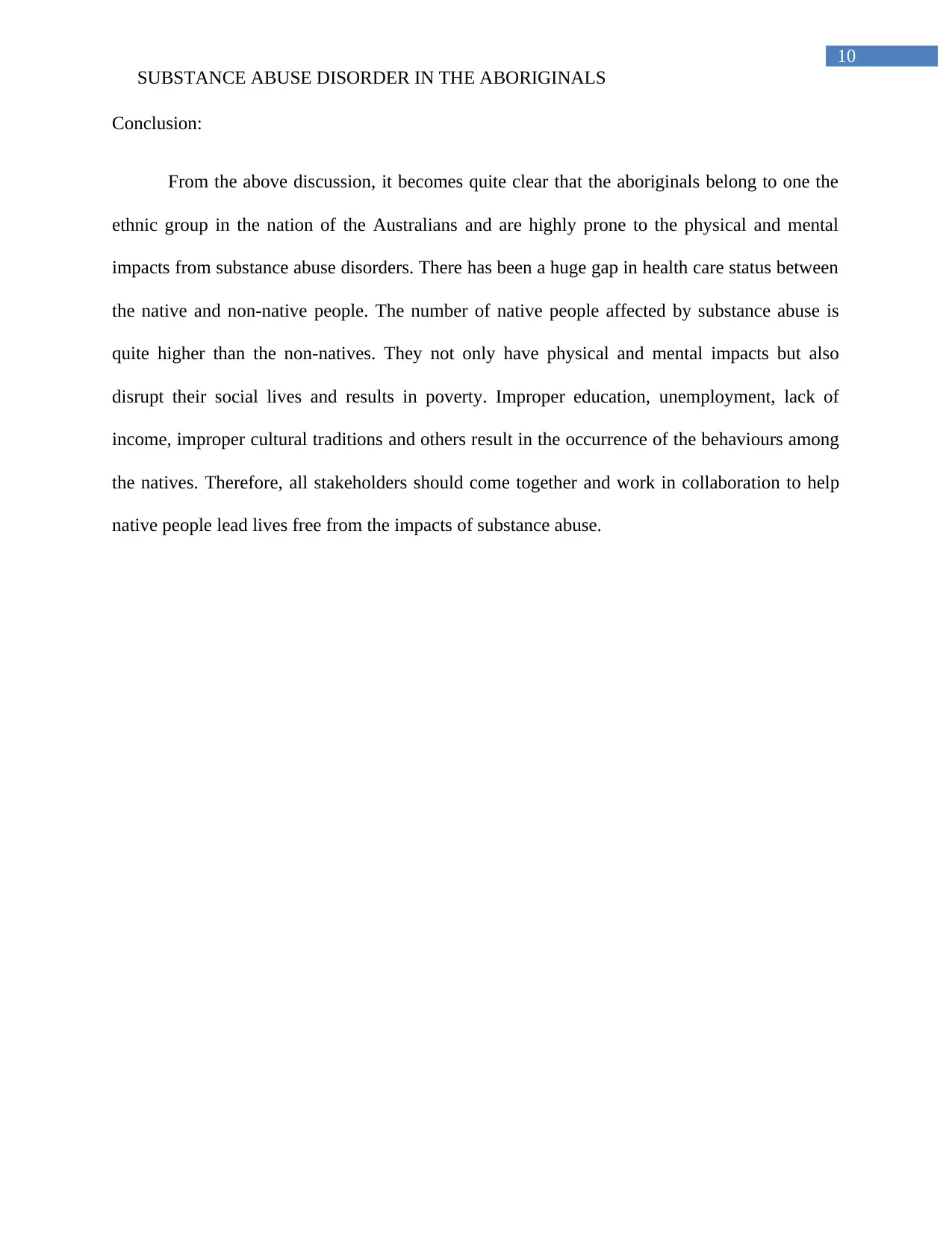
10
SUBSTANCE ABUSE DISORDER IN THE ABORIGINALS
Conclusion:
From the above discussion, it becomes quite clear that the aboriginals belong to one the
ethnic group in the nation of the Australians and are highly prone to the physical and mental
impacts from substance abuse disorders. There has been a huge gap in health care status between
the native and non-native people. The number of native people affected by substance abuse is
quite higher than the non-natives. They not only have physical and mental impacts but also
disrupt their social lives and results in poverty. Improper education, unemployment, lack of
income, improper cultural traditions and others result in the occurrence of the behaviours among
the natives. Therefore, all stakeholders should come together and work in collaboration to help
native people lead lives free from the impacts of substance abuse.
SUBSTANCE ABUSE DISORDER IN THE ABORIGINALS
Conclusion:
From the above discussion, it becomes quite clear that the aboriginals belong to one the
ethnic group in the nation of the Australians and are highly prone to the physical and mental
impacts from substance abuse disorders. There has been a huge gap in health care status between
the native and non-native people. The number of native people affected by substance abuse is
quite higher than the non-natives. They not only have physical and mental impacts but also
disrupt their social lives and results in poverty. Improper education, unemployment, lack of
income, improper cultural traditions and others result in the occurrence of the behaviours among
the natives. Therefore, all stakeholders should come together and work in collaboration to help
native people lead lives free from the impacts of substance abuse.
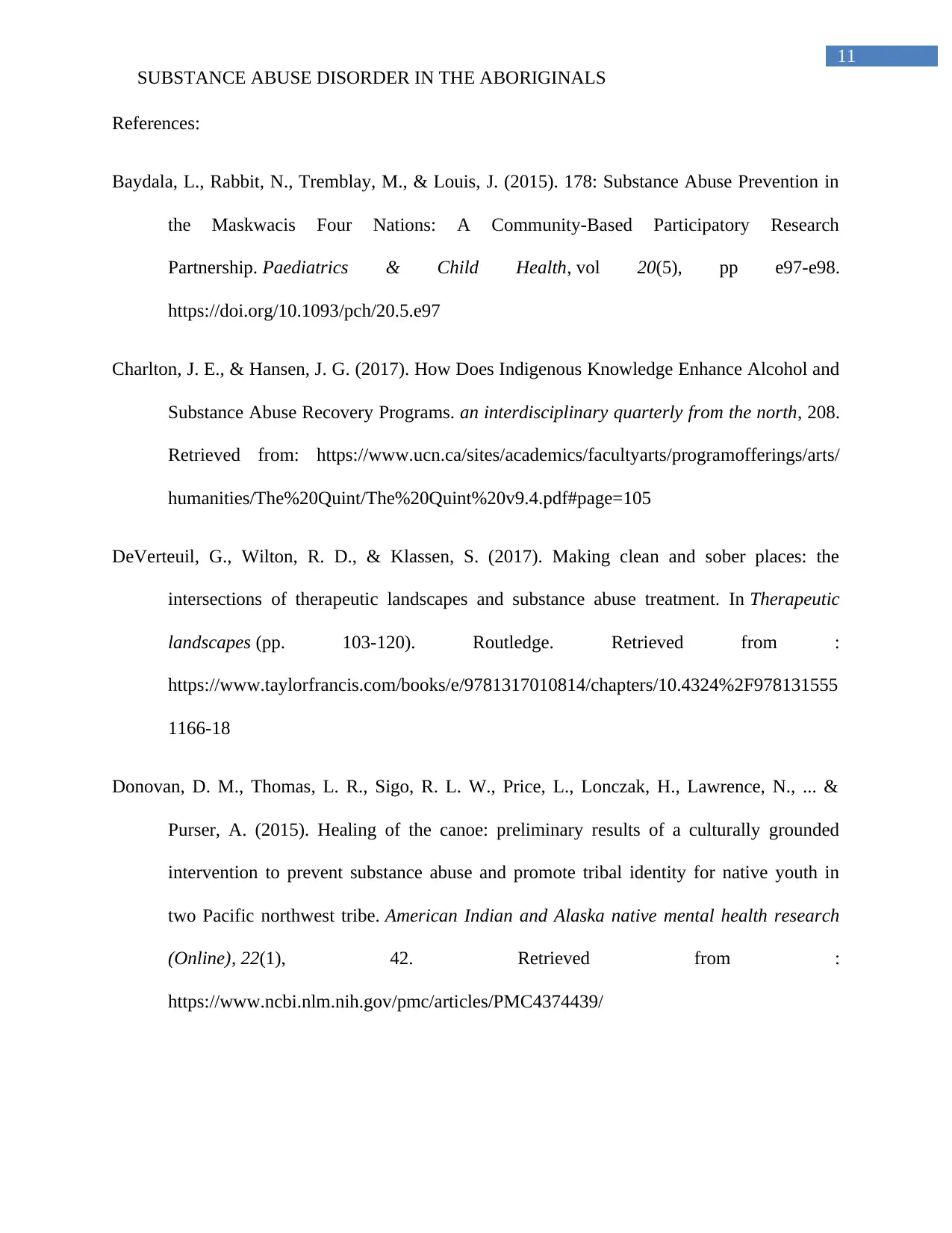
11
SUBSTANCE ABUSE DISORDER IN THE ABORIGINALS
References:
Baydala, L., Rabbit, N., Tremblay, M., & Louis, J. (2015). 178: Substance Abuse Prevention in
the Maskwacis Four Nations: A Community-Based Participatory Research
Partnership. Paediatrics & Child Health, vol 20(5), pp e97-e98.
https://doi.org/10.1093/pch/20.5.e97
Charlton, J. E., & Hansen, J. G. (2017). How Does Indigenous Knowledge Enhance Alcohol and
Substance Abuse Recovery Programs. an interdisciplinary quarterly from the north, 208.
Retrieved from: https://www.ucn.ca/sites/academics/facultyarts/programofferings/arts/
humanities/The%20Quint/The%20Quint%20v9.4.pdf#page=105
DeVerteuil, G., Wilton, R. D., & Klassen, S. (2017). Making clean and sober places: the
intersections of therapeutic landscapes and substance abuse treatment. In Therapeutic
landscapes (pp. 103-120). Routledge. Retrieved from :
https://www.taylorfrancis.com/books/e/9781317010814/chapters/10.4324%2F978131555
1166-18
Donovan, D. M., Thomas, L. R., Sigo, R. L. W., Price, L., Lonczak, H., Lawrence, N., ... &
Purser, A. (2015). Healing of the canoe: preliminary results of a culturally grounded
intervention to prevent substance abuse and promote tribal identity for native youth in
two Pacific northwest tribe. American Indian and Alaska native mental health research
(Online), 22(1), 42. Retrieved from :
https://www.ncbi.nlm.nih.gov/pmc/articles/PMC4374439/
SUBSTANCE ABUSE DISORDER IN THE ABORIGINALS
References:
Baydala, L., Rabbit, N., Tremblay, M., & Louis, J. (2015). 178: Substance Abuse Prevention in
the Maskwacis Four Nations: A Community-Based Participatory Research
Partnership. Paediatrics & Child Health, vol 20(5), pp e97-e98.
https://doi.org/10.1093/pch/20.5.e97
Charlton, J. E., & Hansen, J. G. (2017). How Does Indigenous Knowledge Enhance Alcohol and
Substance Abuse Recovery Programs. an interdisciplinary quarterly from the north, 208.
Retrieved from: https://www.ucn.ca/sites/academics/facultyarts/programofferings/arts/
humanities/The%20Quint/The%20Quint%20v9.4.pdf#page=105
DeVerteuil, G., Wilton, R. D., & Klassen, S. (2017). Making clean and sober places: the
intersections of therapeutic landscapes and substance abuse treatment. In Therapeutic
landscapes (pp. 103-120). Routledge. Retrieved from :
https://www.taylorfrancis.com/books/e/9781317010814/chapters/10.4324%2F978131555
1166-18
Donovan, D. M., Thomas, L. R., Sigo, R. L. W., Price, L., Lonczak, H., Lawrence, N., ... &
Purser, A. (2015). Healing of the canoe: preliminary results of a culturally grounded
intervention to prevent substance abuse and promote tribal identity for native youth in
two Pacific northwest tribe. American Indian and Alaska native mental health research
(Online), 22(1), 42. Retrieved from :
https://www.ncbi.nlm.nih.gov/pmc/articles/PMC4374439/
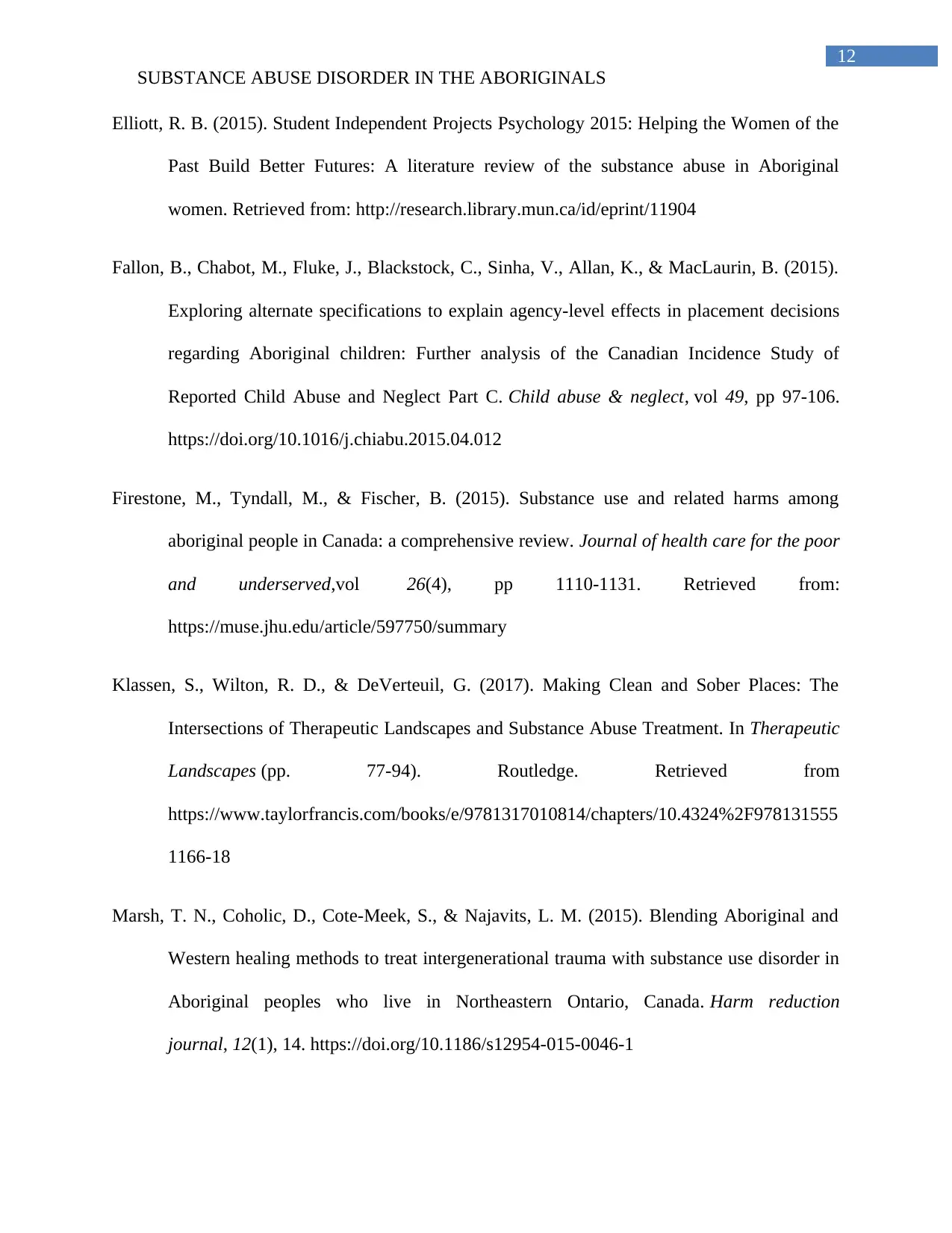
12
SUBSTANCE ABUSE DISORDER IN THE ABORIGINALS
Elliott, R. B. (2015). Student Independent Projects Psychology 2015: Helping the Women of the
Past Build Better Futures: A literature review of the substance abuse in Aboriginal
women. Retrieved from: http://research.library.mun.ca/id/eprint/11904
Fallon, B., Chabot, M., Fluke, J., Blackstock, C., Sinha, V., Allan, K., & MacLaurin, B. (2015).
Exploring alternate specifications to explain agency-level effects in placement decisions
regarding Aboriginal children: Further analysis of the Canadian Incidence Study of
Reported Child Abuse and Neglect Part C. Child abuse & neglect, vol 49, pp 97-106.
https://doi.org/10.1016/j.chiabu.2015.04.012
Firestone, M., Tyndall, M., & Fischer, B. (2015). Substance use and related harms among
aboriginal people in Canada: a comprehensive review. Journal of health care for the poor
and underserved,vol 26(4), pp 1110-1131. Retrieved from:
https://muse.jhu.edu/article/597750/summary
Klassen, S., Wilton, R. D., & DeVerteuil, G. (2017). Making Clean and Sober Places: The
Intersections of Therapeutic Landscapes and Substance Abuse Treatment. In Therapeutic
Landscapes (pp. 77-94). Routledge. Retrieved from
https://www.taylorfrancis.com/books/e/9781317010814/chapters/10.4324%2F978131555
1166-18
Marsh, T. N., Coholic, D., Cote-Meek, S., & Najavits, L. M. (2015). Blending Aboriginal and
Western healing methods to treat intergenerational trauma with substance use disorder in
Aboriginal peoples who live in Northeastern Ontario, Canada. Harm reduction
journal, 12(1), 14. https://doi.org/10.1186/s12954-015-0046-1
SUBSTANCE ABUSE DISORDER IN THE ABORIGINALS
Elliott, R. B. (2015). Student Independent Projects Psychology 2015: Helping the Women of the
Past Build Better Futures: A literature review of the substance abuse in Aboriginal
women. Retrieved from: http://research.library.mun.ca/id/eprint/11904
Fallon, B., Chabot, M., Fluke, J., Blackstock, C., Sinha, V., Allan, K., & MacLaurin, B. (2015).
Exploring alternate specifications to explain agency-level effects in placement decisions
regarding Aboriginal children: Further analysis of the Canadian Incidence Study of
Reported Child Abuse and Neglect Part C. Child abuse & neglect, vol 49, pp 97-106.
https://doi.org/10.1016/j.chiabu.2015.04.012
Firestone, M., Tyndall, M., & Fischer, B. (2015). Substance use and related harms among
aboriginal people in Canada: a comprehensive review. Journal of health care for the poor
and underserved,vol 26(4), pp 1110-1131. Retrieved from:
https://muse.jhu.edu/article/597750/summary
Klassen, S., Wilton, R. D., & DeVerteuil, G. (2017). Making Clean and Sober Places: The
Intersections of Therapeutic Landscapes and Substance Abuse Treatment. In Therapeutic
Landscapes (pp. 77-94). Routledge. Retrieved from
https://www.taylorfrancis.com/books/e/9781317010814/chapters/10.4324%2F978131555
1166-18
Marsh, T. N., Coholic, D., Cote-Meek, S., & Najavits, L. M. (2015). Blending Aboriginal and
Western healing methods to treat intergenerational trauma with substance use disorder in
Aboriginal peoples who live in Northeastern Ontario, Canada. Harm reduction
journal, 12(1), 14. https://doi.org/10.1186/s12954-015-0046-1
Paraphrase This Document
Need a fresh take? Get an instant paraphrase of this document with our AI Paraphraser
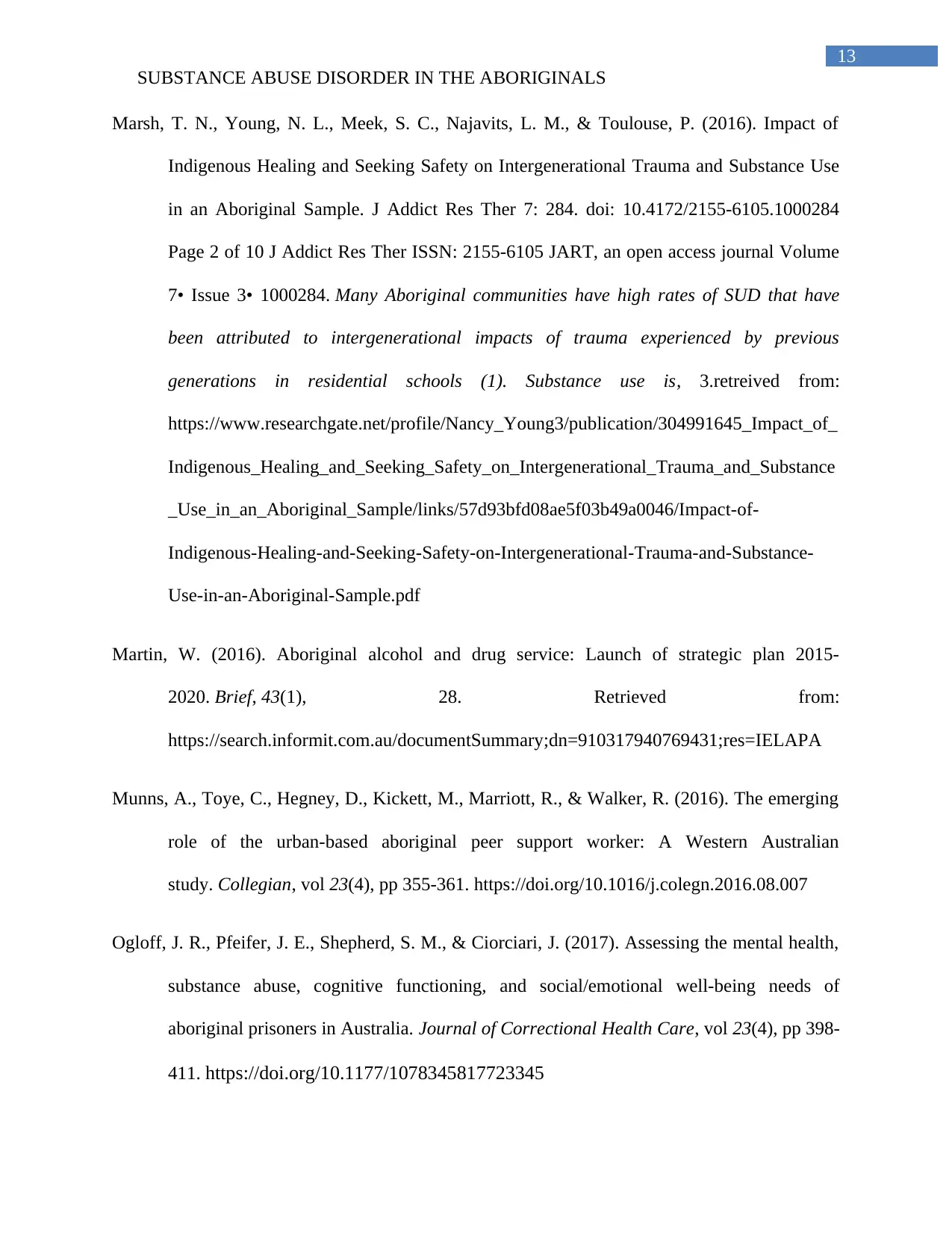
13
SUBSTANCE ABUSE DISORDER IN THE ABORIGINALS
Marsh, T. N., Young, N. L., Meek, S. C., Najavits, L. M., & Toulouse, P. (2016). Impact of
Indigenous Healing and Seeking Safety on Intergenerational Trauma and Substance Use
in an Aboriginal Sample. J Addict Res Ther 7: 284. doi: 10.4172/2155-6105.1000284
Page 2 of 10 J Addict Res Ther ISSN: 2155-6105 JART, an open access journal Volume
7• Issue 3• 1000284. Many Aboriginal communities have high rates of SUD that have
been attributed to intergenerational impacts of trauma experienced by previous
generations in residential schools (1). Substance use is, 3.retreived from:
https://www.researchgate.net/profile/Nancy_Young3/publication/304991645_Impact_of_
Indigenous_Healing_and_Seeking_Safety_on_Intergenerational_Trauma_and_Substance
_Use_in_an_Aboriginal_Sample/links/57d93bfd08ae5f03b49a0046/Impact-of-
Indigenous-Healing-and-Seeking-Safety-on-Intergenerational-Trauma-and-Substance-
Use-in-an-Aboriginal-Sample.pdf
Martin, W. (2016). Aboriginal alcohol and drug service: Launch of strategic plan 2015-
2020. Brief, 43(1), 28. Retrieved from:
https://search.informit.com.au/documentSummary;dn=910317940769431;res=IELAPA
Munns, A., Toye, C., Hegney, D., Kickett, M., Marriott, R., & Walker, R. (2016). The emerging
role of the urban-based aboriginal peer support worker: A Western Australian
study. Collegian, vol 23(4), pp 355-361. https://doi.org/10.1016/j.colegn.2016.08.007
Ogloff, J. R., Pfeifer, J. E., Shepherd, S. M., & Ciorciari, J. (2017). Assessing the mental health,
substance abuse, cognitive functioning, and social/emotional well-being needs of
aboriginal prisoners in Australia. Journal of Correctional Health Care, vol 23(4), pp 398-
411. https://doi.org/10.1177/1078345817723345
SUBSTANCE ABUSE DISORDER IN THE ABORIGINALS
Marsh, T. N., Young, N. L., Meek, S. C., Najavits, L. M., & Toulouse, P. (2016). Impact of
Indigenous Healing and Seeking Safety on Intergenerational Trauma and Substance Use
in an Aboriginal Sample. J Addict Res Ther 7: 284. doi: 10.4172/2155-6105.1000284
Page 2 of 10 J Addict Res Ther ISSN: 2155-6105 JART, an open access journal Volume
7• Issue 3• 1000284. Many Aboriginal communities have high rates of SUD that have
been attributed to intergenerational impacts of trauma experienced by previous
generations in residential schools (1). Substance use is, 3.retreived from:
https://www.researchgate.net/profile/Nancy_Young3/publication/304991645_Impact_of_
Indigenous_Healing_and_Seeking_Safety_on_Intergenerational_Trauma_and_Substance
_Use_in_an_Aboriginal_Sample/links/57d93bfd08ae5f03b49a0046/Impact-of-
Indigenous-Healing-and-Seeking-Safety-on-Intergenerational-Trauma-and-Substance-
Use-in-an-Aboriginal-Sample.pdf
Martin, W. (2016). Aboriginal alcohol and drug service: Launch of strategic plan 2015-
2020. Brief, 43(1), 28. Retrieved from:
https://search.informit.com.au/documentSummary;dn=910317940769431;res=IELAPA
Munns, A., Toye, C., Hegney, D., Kickett, M., Marriott, R., & Walker, R. (2016). The emerging
role of the urban-based aboriginal peer support worker: A Western Australian
study. Collegian, vol 23(4), pp 355-361. https://doi.org/10.1016/j.colegn.2016.08.007
Ogloff, J. R., Pfeifer, J. E., Shepherd, S. M., & Ciorciari, J. (2017). Assessing the mental health,
substance abuse, cognitive functioning, and social/emotional well-being needs of
aboriginal prisoners in Australia. Journal of Correctional Health Care, vol 23(4), pp 398-
411. https://doi.org/10.1177/1078345817723345
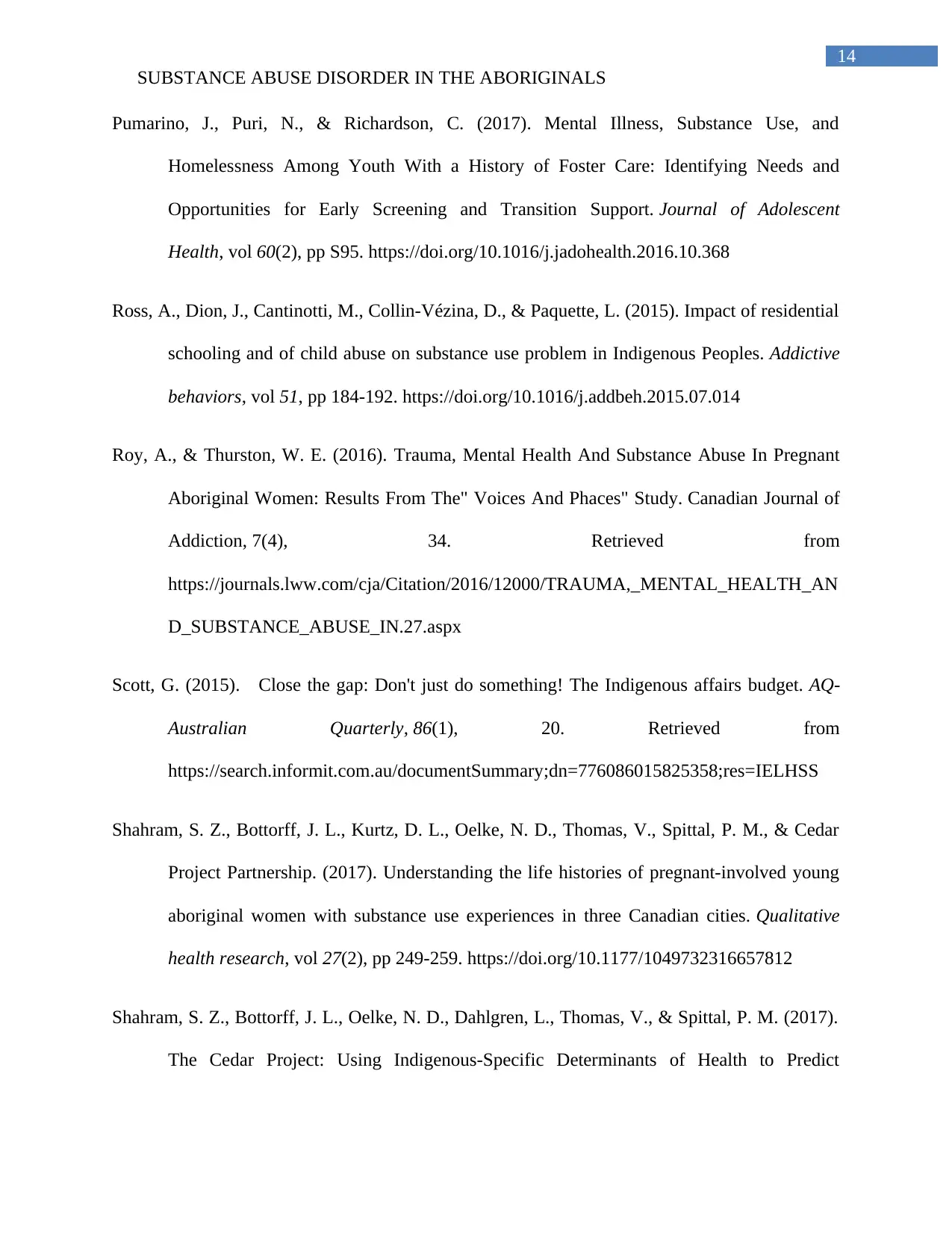
14
SUBSTANCE ABUSE DISORDER IN THE ABORIGINALS
Pumarino, J., Puri, N., & Richardson, C. (2017). Mental Illness, Substance Use, and
Homelessness Among Youth With a History of Foster Care: Identifying Needs and
Opportunities for Early Screening and Transition Support. Journal of Adolescent
Health, vol 60(2), pp S95. https://doi.org/10.1016/j.jadohealth.2016.10.368
Ross, A., Dion, J., Cantinotti, M., Collin-Vézina, D., & Paquette, L. (2015). Impact of residential
schooling and of child abuse on substance use problem in Indigenous Peoples. Addictive
behaviors, vol 51, pp 184-192. https://doi.org/10.1016/j.addbeh.2015.07.014
Roy, A., & Thurston, W. E. (2016). Trauma, Mental Health And Substance Abuse In Pregnant
Aboriginal Women: Results From The" Voices And Phaces" Study. Canadian Journal of
Addiction, 7(4), 34. Retrieved from
https://journals.lww.com/cja/Citation/2016/12000/TRAUMA,_MENTAL_HEALTH_AN
D_SUBSTANCE_ABUSE_IN.27.aspx
Scott, G. (2015). Close the gap: Don't just do something! The Indigenous affairs budget. AQ-
Australian Quarterly, 86(1), 20. Retrieved from
https://search.informit.com.au/documentSummary;dn=776086015825358;res=IELHSS
Shahram, S. Z., Bottorff, J. L., Kurtz, D. L., Oelke, N. D., Thomas, V., Spittal, P. M., & Cedar
Project Partnership. (2017). Understanding the life histories of pregnant-involved young
aboriginal women with substance use experiences in three Canadian cities. Qualitative
health research, vol 27(2), pp 249-259. https://doi.org/10.1177/1049732316657812
Shahram, S. Z., Bottorff, J. L., Oelke, N. D., Dahlgren, L., Thomas, V., & Spittal, P. M. (2017).
The Cedar Project: Using Indigenous-Specific Determinants of Health to Predict
SUBSTANCE ABUSE DISORDER IN THE ABORIGINALS
Pumarino, J., Puri, N., & Richardson, C. (2017). Mental Illness, Substance Use, and
Homelessness Among Youth With a History of Foster Care: Identifying Needs and
Opportunities for Early Screening and Transition Support. Journal of Adolescent
Health, vol 60(2), pp S95. https://doi.org/10.1016/j.jadohealth.2016.10.368
Ross, A., Dion, J., Cantinotti, M., Collin-Vézina, D., & Paquette, L. (2015). Impact of residential
schooling and of child abuse on substance use problem in Indigenous Peoples. Addictive
behaviors, vol 51, pp 184-192. https://doi.org/10.1016/j.addbeh.2015.07.014
Roy, A., & Thurston, W. E. (2016). Trauma, Mental Health And Substance Abuse In Pregnant
Aboriginal Women: Results From The" Voices And Phaces" Study. Canadian Journal of
Addiction, 7(4), 34. Retrieved from
https://journals.lww.com/cja/Citation/2016/12000/TRAUMA,_MENTAL_HEALTH_AN
D_SUBSTANCE_ABUSE_IN.27.aspx
Scott, G. (2015). Close the gap: Don't just do something! The Indigenous affairs budget. AQ-
Australian Quarterly, 86(1), 20. Retrieved from
https://search.informit.com.au/documentSummary;dn=776086015825358;res=IELHSS
Shahram, S. Z., Bottorff, J. L., Kurtz, D. L., Oelke, N. D., Thomas, V., Spittal, P. M., & Cedar
Project Partnership. (2017). Understanding the life histories of pregnant-involved young
aboriginal women with substance use experiences in three Canadian cities. Qualitative
health research, vol 27(2), pp 249-259. https://doi.org/10.1177/1049732316657812
Shahram, S. Z., Bottorff, J. L., Oelke, N. D., Dahlgren, L., Thomas, V., & Spittal, P. M. (2017).
The Cedar Project: Using Indigenous-Specific Determinants of Health to Predict
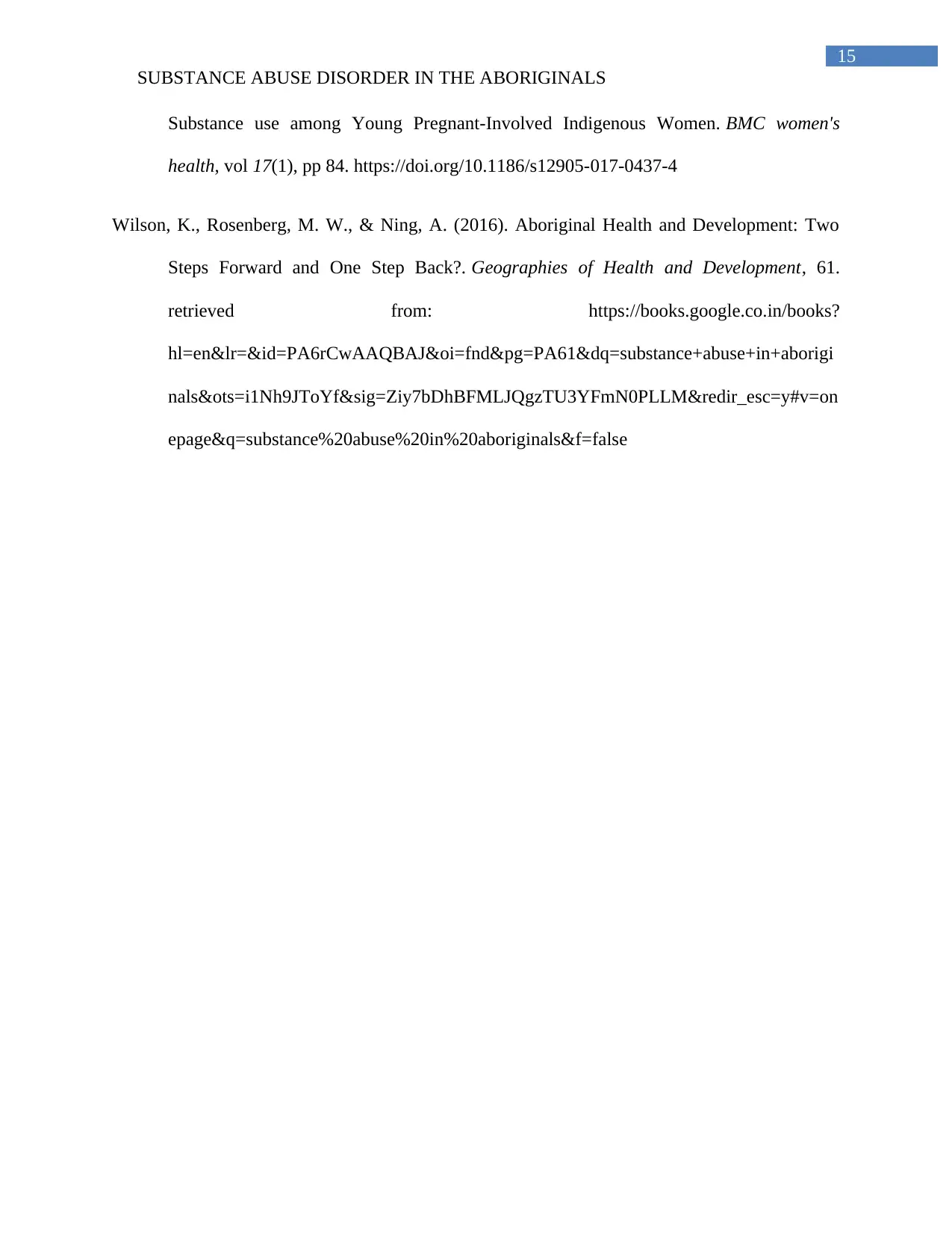
15
SUBSTANCE ABUSE DISORDER IN THE ABORIGINALS
Substance use among Young Pregnant-Involved Indigenous Women. BMC women's
health, vol 17(1), pp 84. https://doi.org/10.1186/s12905-017-0437-4
Wilson, K., Rosenberg, M. W., & Ning, A. (2016). Aboriginal Health and Development: Two
Steps Forward and One Step Back?. Geographies of Health and Development, 61.
retrieved from: https://books.google.co.in/books?
hl=en&lr=&id=PA6rCwAAQBAJ&oi=fnd&pg=PA61&dq=substance+abuse+in+aborigi
nals&ots=i1Nh9JToYf&sig=Ziy7bDhBFMLJQgzTU3YFmN0PLLM&redir_esc=y#v=on
epage&q=substance%20abuse%20in%20aboriginals&f=false
SUBSTANCE ABUSE DISORDER IN THE ABORIGINALS
Substance use among Young Pregnant-Involved Indigenous Women. BMC women's
health, vol 17(1), pp 84. https://doi.org/10.1186/s12905-017-0437-4
Wilson, K., Rosenberg, M. W., & Ning, A. (2016). Aboriginal Health and Development: Two
Steps Forward and One Step Back?. Geographies of Health and Development, 61.
retrieved from: https://books.google.co.in/books?
hl=en&lr=&id=PA6rCwAAQBAJ&oi=fnd&pg=PA61&dq=substance+abuse+in+aborigi
nals&ots=i1Nh9JToYf&sig=Ziy7bDhBFMLJQgzTU3YFmN0PLLM&redir_esc=y#v=on
epage&q=substance%20abuse%20in%20aboriginals&f=false
1 out of 16
Related Documents
Your All-in-One AI-Powered Toolkit for Academic Success.
+13062052269
info@desklib.com
Available 24*7 on WhatsApp / Email
![[object Object]](/_next/static/media/star-bottom.7253800d.svg)
Unlock your academic potential
© 2024 | Zucol Services PVT LTD | All rights reserved.





